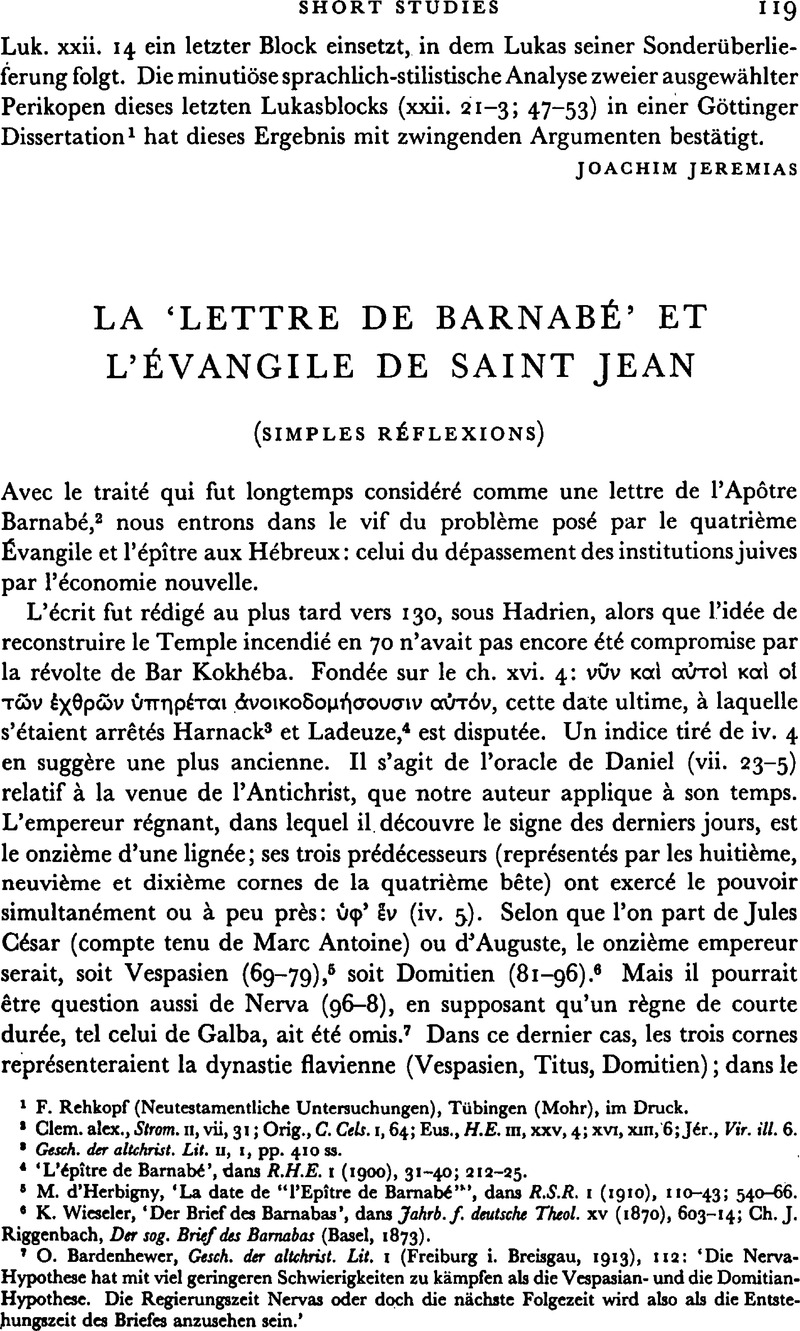No CrossRef data available.
Published online by Cambridge University Press: 05 February 2009

page 119 note 1 Rehkopf, F. (Neutestamentliche Untersuchungen), Tubingen (Mohr), im Druck.Google Scholar
page 119 note 2 Clem. alex., Strom. II, vii, 31; Orig., C. Cels. I, 64; Eus., H.E. III, XXV, 4; XVI, XIII, 6; Jer., Vir. iii. 6.Google Scholar
page 119 note 3 Gesch. der aitchyist. Lit. II, I, pp. 410 ss.Google Scholar
page 119 note 4 ‘L'pîttre de Barnabé’, dans R.H.E. I (1900), 31–40; 212–25.Google Scholar
page 119 note 5 d'Herbigny, M., ‘La date de “l'Epître de Barnabé”’, dans R.S.R. I (1910), 110–43; 540–66.Google Scholar
page 119 note 6 Wieseler, K., ‘Der Brief des Barnabas’, dans Jahrb. f. deutsche Theol. XV (1870), 603–14;Google Scholar Ch. Riggenbach, J., Der sog. Brief des Barnabas (Basel, 1873).Google Scholar
page 119 note 7 Bardenhewer, O., Gesch. der altchyist. Lit. I (Freiburg i. Breisgau, 1913), 112: ‘Die Nerva. Hypothese hat mit viel geringeren Schwierigkeiten zu kämpfen ala die Vespasian- und die Domitian-Hypothese. Die Regierungszeit Nervas oder doch die nächste Folgezeit wird also als die Entstehungszeit des Briefes anzusehen sein.’Google Scholar
page 120 note 1 Cf. Heinisch, P., Der Einfluss Philos auf die ältesfe chrisilithe Exegese (Barnabas, Justin und Klemens von Alexandrien), (Münster i. W., 1908).Google Scholar
page 121 note 1 Sur le symbolique des lettres tau et tav dans le judaisme postérieur et le christianisme primitif, voir Michaelis, W., ‘Zeichen, Siegel, Kreuz’, dans T.Z. XII (1956), 504–25.Google Scholar
page 122 note 1 A propos de la typologie du sacrifice d'Abraham, voir Danielou, J., Sacramentum Futuri. Études sur les origines de la typologie biblique (Paris, 1950), pp. 97–128.Google Scholar
page 122 note 2 Geschichte des neutestamentlichen Kanons, I (Erlangen und Leipzig, 1889), 906 s.Google Scholar
page 122 note 3 An Inquiry into the Character and Authorship of the Fourth Gospel (London, 1903), p. 257: ‘1 think that it is rash to assert either that the Epistle was influenced by the Gospel, or that the Gospel must be a later production.’Google Scholar
page 123 note 1 Cf. von Loewenisch, W., Das Johannes-Verständnis im zweiten Jahrhundert (Beih. f. N.T.W. 13), (Giessen, 1932), p. 18: ‘Hat. B. Joh. gekannt? Wir können es nicht beweisen, freilich ebensowenig das Gegenteil.’Google Scholar
page 123 note 2 Voir notre étude: ‘L'Arrière-fond judaïque du quatrième Évangile et la communauté de l'Alliance’, dans R.B. LXII (1955), 5–44.Google Scholar
page 123 note 3 Cf. Audet, J. P., ‘Affinités littéraires et doctinales du Manuel de Discipline’, dans R.B. LIX (1952), 220 ss.Google Scholar